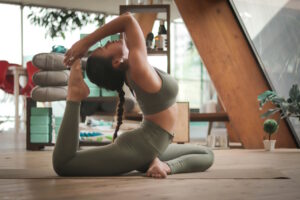
Flexibility is a fundamental aspect of physical fitness that contributes to overall well-being. Whether you’re an athlete aiming to enhance performance, someone looking to relieve muscle tension, or simply seeking to move more freely, flexibility plays a vital role in achieving these goals. Pilates, an exercise system known for its holistic approach, can be a powerful tool for improving flexibility. In this guide, we will explore how Pilates can make you more flexible, compare it to yoga in terms of flexibility benefits, highlight specific Pilates exercises that boost flexibility, and discuss the time it takes to achieve greater flexibility through Pilates.
Will Pilates make you flexible?
Yes, Pilates can indeed make you more flexible. Here’s how Pilates can help improve flexibility:
1. Stretching and Lengthening: Pilates incorporates a wide range of stretching exercises that target various muscle groups. These stretches help elongate muscles, reduce tension, and improve flexibility.
2. Controlled Movements: Pilates emphasizes controlled and precise movements. This controlled approach to exercise allows you to focus on stretching and elongating muscles effectively and safely.
3. Full-Body Engagement: Pilates engages muscles throughout the entire body, including those that support flexibility. Strengthening and balancing these muscles can enhance overall flexibility.
4. Improved Range of Motion: Pilates movements often take joints and muscles through a full range of motion. This helps to increase joint flexibility and mobility.
5. Mind-Body Connection: Pilates encourages a strong mind-body connection, promoting body awareness. This heightened awareness can help you tune in to your body’s signals and work on areas that need more attention regarding flexibility.
6. Consistent Practice: Like any form of exercise, consistency is key. Regular Pilates practice over time can lead to noticeable improvements in flexibility.
It’s important to note that the degree of flexibility improvement varies from person to person and depends on factors such as your starting point, frequency of practice, and dedication to proper technique.
Is yoga or Pilates better for flexibility?
Both yoga and Pilates can significantly improve flexibility, but they do so in slightly different ways:
1. Yoga: Yoga is well-known for its emphasis on flexibility, and many yoga poses involve deep stretches and holds. It often includes a variety of poses that target different muscle groups, contributing to overall body flexibility. Yoga also places a strong focus on breath awareness and relaxation, which can help muscles release tension and lengthen.
2. Pilates: Pilates also incorporates stretching and lengthening exercises, with an emphasis on controlled and precise movements. Pilates engages and strengthens the core, which provides stability and support for flexibility. While Pilates stretches are incorporated throughout the practice, they are often integrated into dynamic movements, promoting both strength and flexibility simultaneously.
The choice between yoga and Pilates for improving flexibility ultimately depends on your personal preferences and fitness goals. Some individuals may prefer the slower, meditative pace of yoga, while others may enjoy the dynamic and core-strengthening aspects of Pilates. Many people find value in practicing both yoga and Pilates to enhance overall flexibility and well-being.
What Pilates exercises help with flexibility?
Several Pilates exercises specifically target and improve flexibility. Here are some effective ones:
*1. The Saw: The Saw is an exercise that stretches the spine and hamstrings while engaging the core. It helps improve spinal flexibility and rotational mobility.
*2. Swan Dive: Swan Dive is excellent for elongating the spine and stretching the chest, shoulders, and abdominal muscles. It also promotes flexibility in the hip flexors and quadriceps.
*3. Mermaid Stretch: This seated stretch opens up the sides of the body, promoting lateral flexibility. It’s especially beneficial for improving the flexibility of the spine and waist.
*4. Spine Stretch Forward: This seated exercise targets the back, hamstrings, and calves. It helps improve forward flexion of the spine and hamstring flexibility.
*5. Open-Leg Rocker: Open-Leg Rocker is a dynamic exercise that involves rolling backward and forward while stretching the back and hamstrings. It’s excellent for spinal articulation and hamstring flexibility.
*6. Hip Circles: Hip Circles are performed on hands and knees, involving circular movements of the hips. This exercise enhances hip mobility and flexibility.
*7. Leg Pull Front: Leg Pull Front is a plank-like exercise that challenges the core and engages the entire body. It promotes spinal flexibility and strength.
How long does it take to get flexible with Pilates?
The time it takes to achieve greater flexibility through Pilates varies from person to person and depends on several factors:
1. Starting Point: Your current level of flexibility plays a significant role. Individuals who are already somewhat flexible may notice improvements more quickly than those who are starting from a less flexible point.
2. Consistency: Consistent Pilates practice is key to achieving and maintaining flexibility gains. Regular practice, ideally several times a week, is more likely to yield noticeable results.
3. Proper Technique: Correct technique is crucial for effective and safe stretching. Working with a qualified Pilates instructor who can guide you in proper form and alignment can accelerate your progress.
4. Individual Factors: Each person’s body responds differently to exercise. Factors such as age, genetics, and overall health can influence the rate of flexibility improvement.
5. Goals: The specific flexibility goals you set can also impact the timeline. Gradual, sustained progress is often more sustainable and safer than attempting to rush flexibility gains.
In summary, Pilates can make you more flexible by incorporating stretching, controlled movements, full-body engagement, and a mind-body connection into its practice. While both yoga and Pilates can improve flexibility, the choice between the two depends on personal preferences and fitness goals. To enhance flexibility through Pilates, consistent practice of specific flexibility-enhancing exercises is essential. The time it takes to get flexible varies from person to person and depends on factors like starting point, consistency, technique, individual factors, and goals. Ultimately, with dedication and proper guidance, Pilates can be a rewarding path to greater flexibility and improved overall well-being.